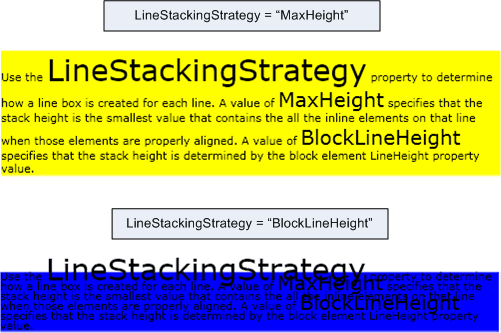TextBlock.LineStackingStrategy Proprietà
Definizione
Importante
Alcune informazioni sono relative alla release non definitiva del prodotto, che potrebbe subire modifiche significative prima della release definitiva. Microsoft non riconosce alcuna garanzia, espressa o implicita, in merito alle informazioni qui fornite.
Ottiene o imposta il meccanismo mediante il quale viene determinata una casella della riga per ogni riga di testo all'interno dell'oggetto TextBlock.
public:
property System::Windows::LineStackingStrategy LineStackingStrategy { System::Windows::LineStackingStrategy get(); void set(System::Windows::LineStackingStrategy value); };public System.Windows.LineStackingStrategy LineStackingStrategy { get; set; }member this.LineStackingStrategy : System.Windows.LineStackingStrategy with get, setPublic Property LineStackingStrategy As LineStackingStrategyValore della proprietà
Meccanismo mediante il quale viene determinata una casella della riga per ogni riga di testo all'interno dell'oggetto TextBlock. Il valore predefinito è MaxHeight.
Esempio
Nell'esempio seguente viene illustrato come utilizzare la LineStackingStrategy proprietà per determinare come vengono create le caselle di riga per le righe di testo di un oggetto TextBlock. Il primo TextBlock ha un LineStackingStrategy valore e MaxHeight il secondo TextBlock ha un valore .BlockLineHeight
<Page xmlns="http://schemas.microsoft.com/winfx/2006/xaml/presentation"
xmlns:x="http://schemas.microsoft.com/winfx/2006/xaml">
<StackPanel>
<!-- This TextBlock has a LineStackingStrategy set to "MaxHeight". -->
<TextBlock LineStackingStrategy="MaxHeight" LineHeight="10" Width="500" TextWrapping="Wrap"
Background="Yellow">
Use the <Span FontSize="30">LineStackingStrategy</Span> property to determine how a line box is
created for each line. A value of <Span FontSize="20">MaxHeight</Span> specifies that the stack
height is the smallest value that contains all the inline elements on that line when those
elements are properly aligned. A value of <Span FontSize="20">BlockLineHeight</Span> specifies
that the stack height is determined by the block element LineHeight property value.
</TextBlock>
<!-- Here is the same TextBlock but the LineStackingStrategy is set to "BlockLineHeight". -->
<TextBlock LineStackingStrategy="BlockLineHeight" LineHeight="10" Width="500" TextWrapping="Wrap"
Background="Blue" Margin="0,40,0,0">
Use the <Span FontSize="30">LineStackingStrategy</Span> property to determine how a line box is
created for each line. A value of <Span FontSize="20">MaxHeight</Span> specifies that the stack
height is the smallest value that contains all the inline elements on that line when those
elements are properly aligned. A value of <Span FontSize="20">BlockLineHeight</Span> specifies
that the stack height is determined by the block element LineHeight property value.
</TextBlock>
</StackPanel>
</Page>
La figura seguente mostra il risultato del codice precedente.

Commenti
Questa proprietà di dipendenza ha anche un utilizzo delle proprietà associate. In XAML l'utilizzo è <object TextBlock.LineStackingStrategy="value".../>, dove l'oggetto è un elemento oggetto (in genere un elemento di flusso) contenuto in un TextBlockoggetto e il valore è un valore stringa dell'enumerazione LineStackingStrategy . Nel codice l'utilizzo delle proprietà associate è supportato da GetLineStackingStrategy e SetLineStackingStrategy. L'utilizzo delle proprietà associate non è comune.
Informazioni proprietà di dipendenza
| Campo Identificatore | LineStackingStrategyProperty |
Proprietà dei metadati impostate su true |
AffectsMeasure, AffectsRender |
